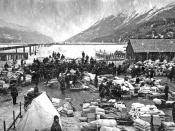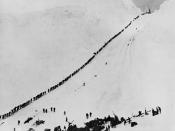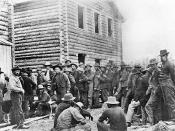GOLD FEVER
The Klondike Gold Rush was the greatest of the eleven gold discoveries in the northern territories of Alaska (USA) and Yukon (Canada) between 1861 and 1899. Since the Klondike showered the stampeders (people who took part in the Klondike gold rush) with the most gold, it attracted a lot of prospectors (people who searched for gold or other precious metals). Prospectors from the United States of America and Canada went up north in hopes of striking the mother lode (the main vein of ore or gold in an area where many smaller veins of gold are found). Of the 100,000 stampeders from USA and Canada who set out for the Klondike gold rush in Yukon, only half arrived, only 400 found gold, only a few hundred had found enough gold to be considered rich, and only a couple had invested their money wisely. Luck, intelligence, following the law, complying with the Yukon Code, and sometimes deceit, were the weapons and the allies of a successful person in the Gold Rush.
Robert Henderson, George Carmack, Skookum Jim and Tagish Charlie were the lucky ones who began the Gold Rush. In the early summer of 1896, Henderson and some other prospectors had taken $750 worth of gold from a creek Henderson named Gold Bottom. During that summer, he met George Carmack, a white man who had adopted the natives' lifestyle, and his friends Tagish Charlie and Skookum Jim. He told them about his discovery, because of the Yukon Code (the unwritten code among the prospectors): when someone found an unusual amount of gold, he should share the good news with other prospectors. When the three said that they would stake some claims at Gold Bottom, Henderson objected because of the three were Siwash (what prospectors named the natives...


